 Red River: The Early Years
Red River: The Early Years
by Tim I. Purdy
6×9; 136 pages, softcover
ISBN: 978-0-938373-96-4
Price $24.95
(out of stock)
Red River: The Early Years is the first of a four volume series exploring the many facets of the Red River Lumber Company. With its June 2011 release, it culminates thirty years of research about one of Lassen County’s most fascinating companies. This is the first book concerning Red River’s operation at Westwood, California to utilize T.B. Walker’s archival papers, housed at the Minnesota Historical Society, which for years were not accessible to the public.
This volume includes many intriguing stories such as the contentious issue where to locate the first mill: Fall River Mills, Mountain Meadows or Susanville. Equally important, is the revelation how the timberlands were acquired; the little known bond issue to finance the construction of Westwood, are among a variety of topics reviewed.
Of course, there was one thing T.B. Walker did not like about California was its political climate. In 1913, he wrote to his son, Willis, “The California Legislature is a sly, reckless gang of socialists, and have succeeded in completely deceiving the people through which they can make a successful war against capital and enterprise.” Included are over fifty historical photographs.
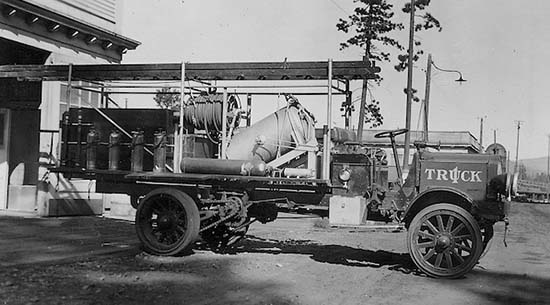
 Red River: The Glory Years
Red River: The Glory Years
by Tim I. Purdy
6×9; 135 pages, softcover
ISBN: 978-0-938373-97-8
Price $24.95
(out of stock)
The second installment in the Red River series, released in April 2012 showcases the best of times at Westwood from 1917 to 1928.
It was exciting times beginning in 1917 with T.B. Walker’s historic visit, and that of California Governor Stephens, too; the big fire, and Westwood’s patriotism by buying $50,000 in Liberty Bonds to fund World War I.
Westwood was transformed from a glorified logging camp to a vibrant community. Many of its memorable landmarks were built in this era ranging from the People’s Church to the Masonic Hall.
Equally important it was no longer a sawmill town. By 1925 with the installation of the half-million dollar Veneer Plant, it became a major lumber manufacturing facility, as only ten percent of the workforce worked in the sawmill. Included are over sixty historical photographs.

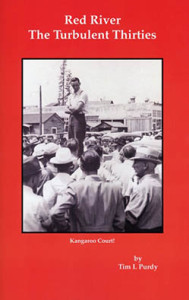 Red River: The Turbulent Thirties
Red River: The Turbulent Thirties
by Tim I. Purdy
6×9; 139 pages, softcover
ISBN: 978-0-938373-98-6
Price $24.95
[Out of Print)]
The third installment of the Red River series examines the 1930s. It was a decade of turmoil for Red River. First the company was faced with its own financial crisis, unable to pay off its accumulated debt. The company owed nearly two million dollars and had no funds to pay its bondholders. The banks reluctantly agreed to refinance the company, but ousted Willis Walker as President for his “reckless” behavior. There were more changes where Westwood became a town of one company instead of a company town. It was deemed outside interests could better handle all the non-lumber business, i.e., operating the Big Store, Westwood Club, and the Westwood National Bank to name a few. The Big Store was leased to Kilpatric & Sons, while Bank of America took over the Westwood National Bank. Then there was the repeal of Prohibition and Westwood was no longer going to be a “dry” town.
If that was not enough to contend with, there were the labor issues. During the early years at Westwood, Red River had been more or less immune from organized labor. Along came the nation’s depression where Franklin Roosevelt was elected the country’s President. President Roosevelt’s new policies, such as the Wagner Act, opened the door for unions, and the stage was set for a union battle over who would represent Red River employees—CIO or IEU. By the summer of 1938, Red River considered it “business suicide” to continue to operate the plant. It was a show down; the employees either accept a 17.5% wage reduction or the mill would close. This led to the riot of July 13, between the CIO and IEU wherein over 500 men, women and children affiliated with the CIO were purged from the town. Some historians contend that this was the largest forced migration of United States citizens until the 1941 deportation of Japanese-Americans. Labor problems continued to plague Red River with a second strike in 1939 that lasted nearly eight weeks, which caused another riot and the demolition of the CIO headquarters.
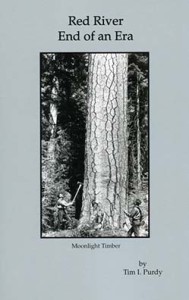 Red River: End of an Era
Red River: End of an Era
by Tim I. Purdy
6×9; 136 pages, softcover
ISBN: 978-0-938373-99-4
Price $24.95
This is the final installment in the Red River series. In 1940 reality set in and it was time for Red River to get out of the lumber business at Westwood. It was easier said than done. To complicate matters, the demand for lumber was the highest Red River had witnessed since 1917. With the mill running at full capacity for the first time in decades, it was profitable; it no longer looked like the “lemon” it was. How long the good times would last.
Revealed are the details of the sale, but this volume also explores other facets of Westwood. While the 1930s were not all doom and gloom for Red River, with the construction of the Western Pacific and Great Northern Railroads Inside Gateway, Westwood now had a second railroad, something its founder, T.B. Walker always desired. After the golden spike ceremony in 1931, Red River launched its Paul Bunyan Prosperity Special train, consisting of 171 carloads of lumber and lumber byproducts. Yet, on the horizon, an important change was to occur with its logging operation and the conversion from railroad to trucks. Yet, railroad logging did not fade away as fast as anticipated and was front and center with the Camp Bunyan and Piute lines.
A surprise bonus includes features ranging from the Westwood National Bank to the less glamorous golf course. Red River’s ancillary history could not be complete without the outside influence of the roadhouses that sprung up east of Westwood—Deerhaven, The Meadows, The 101 Nite Club, and Tunison’s (also known as Phil’s Place).
The Red River Lumber Company
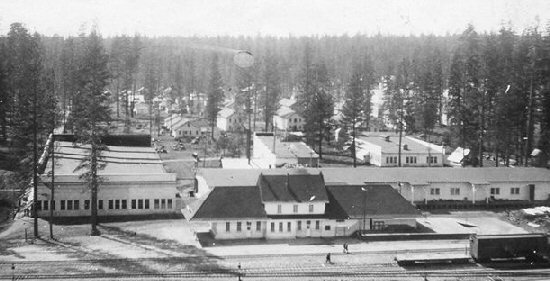
On September 1, 1981, I had an opportunity to visit the Minnesota Historical Society at St. Paul. It just happened to be a coincidence on that date as it was first day that restrictions were lifted on the T.B. Walker and Red River Lumber Company’s papers. In addition, I have been fortunate to meet with Harriett Walker Henderson, the 100 year old granddaughter of T.B. Walker. Of note, Harriett, the daughter of Clinton Walker, was present when the first tree was felled at Westwood in 1912. With these and other unique sources yields a wealth of material never presented.
In the late 1860s, T.B. Walker ventured into the lumber business in northern Minnesota. That laid the foundation for what would become Walker’s empire. During those early years, Walker had many partnerships, one of which in 1884 created the establishment of the Red River Lumber Company. In addition, along with another business partner, Healy Cady Akeley, they established a town and lumber mill—Akeley, Hubbard County, Minnesota. The Akeley facility operated from 1899 to 1915.
It was, however, in 1889 when T.B. Walker looked to the west, more specifically the forests of Northern California. By 1894, Walker began acquisitions of timberlands there. By 1905, he owned an estimated 900,000 acres in Lassen, Plumas, Siskiyou, Shasta and Tehama Counties.
Walker was stymied by the development of these lands due to the lack adequate railroad facilities. Walker’s original concept was to establish several sawmills through this vast forest domain. Two particular events changed those plans. One was the purchase of John Crouch lands at Mountains Meadows, Lassen County. The other was an agreement with the Southern Pacific Railroad.
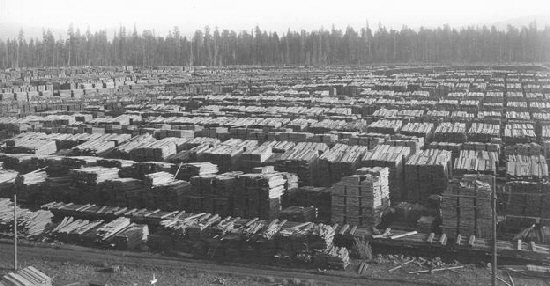 In 1912, plans had been drawn to establish a company town and sawmill in Mountain Meadows. On Tuesday, September 10,1912, T.B. Walker’s son, Clinton, with his two small children, Brooks and Harriett and W.B. Carlin, construction superintendent of the mill and town, did the ceremonial cutting of the first tree at what would become the company town of Westwood.
In 1912, plans had been drawn to establish a company town and sawmill in Mountain Meadows. On Tuesday, September 10,1912, T.B. Walker’s son, Clinton, with his two small children, Brooks and Harriett and W.B. Carlin, construction superintendent of the mill and town, did the ceremonial cutting of the first tree at what would become the company town of Westwood.
For the next thirty-two years Walker’s Red River Lumber Company controlled the town of Westwood and its environs. While it took the region to adjust to the economic impact of this development, there were also the political clout that had far ranging effects too. In 1918, the Lassen County Board of Supervisors had criticized the Company for not allowing a speaker who was against the prohibition movement to assemble in Westwood. Company Manager, R.F. Pray informed the Board not to meddle with the Company’s policies. Pray then continued had they not urged their employees to vote for the passage of the bond measures for a new County Courthouse and Hospital, those facilities would never have been built.
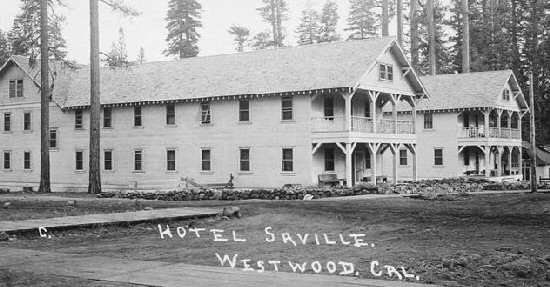 The conflicts were not confined to politics, but that inside the family, too. When Red River established Westwood, T.B. Walker began turning over the management to his five sons—Gilbert, Fletcher, Willis, Clinton and Archie. Each son had their own ideas as to how the company should be run and the power struggles were notorious. Gilbert was the first casualty who suffered a mental breakdown. Clinton, the maverick, broke ties with the Company in 1913 over the management of Westwood, but would be forced back into the Company during its financial crisis of the Depression. Fletcher and Willis had their battles as to how Westwood should operate too, while Archie remained in Minnesota to soothe the bankers and investors who provided the necessary capital for the California operations.
The conflicts were not confined to politics, but that inside the family, too. When Red River established Westwood, T.B. Walker began turning over the management to his five sons—Gilbert, Fletcher, Willis, Clinton and Archie. Each son had their own ideas as to how the company should be run and the power struggles were notorious. Gilbert was the first casualty who suffered a mental breakdown. Clinton, the maverick, broke ties with the Company in 1913 over the management of Westwood, but would be forced back into the Company during its financial crisis of the Depression. Fletcher and Willis had their battles as to how Westwood should operate too, while Archie remained in Minnesota to soothe the bankers and investors who provided the necessary capital for the California operations.
Of course, there are the labor issues. Take for instance, as documented in the Company’s archives is that of employee badge No. 96. This person was hired in 1922 as a Company spy to mingle with the employees looking for anyone in regards to union organizing.
The American Legion Hall
On July 15, 1918, Westwood resident Clyde A. McKea died in combat in France, making him the first casualty from Lassen County of World War I. In the fall of 1919 a new national veterans organization was formed—The American Legion.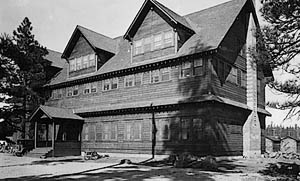
On June 20, 1919, a Group of World War I veterans organized the McKea Post, named in honor of their fallen comrade. On October 4, 1919, they received their charter and became officially known as the American Legion McKea Post No. 80. The new organization struggled to attract members and by 1924, its membership roster consisted of a group of ten men.
Big changes for the McKea Post and Westwood in general were on the horizon. In the fall of 1924 Red River announced its intention to complete its sawmill and manufacturing plant with the installation of a Plywood/Veneer Plant. The McKea Post happened to be a very fortunate beneficiary of this decision. Red River needed a venue to showcase its new veneer panels.
In December 1924, Red River announced they would build a hall for the American Legion. The site selected was at 409 Ash Street. This would be no ordinary hall, but an impressive three-story structure, making it at that time the tallest building in Westwood.
On June 2, 1925, the McKea Post held their first meeting in the new hall. An open house was delayed for a month, until the furnishings arrived. When opened to the public, the visitors were impressed. The first floor consisted of a large meeting room, which was utilized for banquets and dancing. The ceiling was adorned with massive wooden beams, and the room was paneled with Red River’s newest product—Paul Bunyan’s California Pine Plywood. The second and third floors were bachelor apartments. Income from the apartments provided the funds necessary to operate and maintain the building.
The building’s life as the American Legion Hall was short-lived. In 1936, as part of Red River’s re-organization, it was converted into a hotel known as the Blue Ox Inn. That is another story, for another time.
Our Lady of the Snows
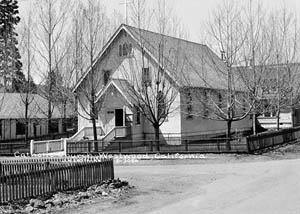 When Westwood was established, its Catholic community was a part of the Sacred Heart Parish—it had only been created in 1912 and covered the territory of Lassen and Modoc counties. The first pastor was Father P.J. O’Reilly. There seems to be some confusion as to when the first Mass was celebrated in Westwood. On December 12, 1913, it was reported in the Lassen Weekly Mail: “Father P.J. O’Reilly made the trip to Westwood to attend to spiritual wants of the Catholic Church in the new lumber town.” However, under the heading of Remarks in the Parish Death Register, Father O’Reilly wrote, “Mass was celebrated in Westwood for the first time by Rev. P.J. O’Reilly on 19 April 1914 in the school house situated near the present fire department. Mass is now said in the school situated on the hill facing Delwood Street.” Father also wrote, “The first Catholic funeral that was held in Westwood was on July 24, 1914. The internment was made in the new cemetery, portion of which viz the North East section is devoted to the use of the Catholics who die in and around Westwood for Catholics only. This cemetery is 3 1/2 miles from Westwood.” That internment was for Jose Alvarez, a 22 year-old millworker who died from typhoid fever
When Westwood was established, its Catholic community was a part of the Sacred Heart Parish—it had only been created in 1912 and covered the territory of Lassen and Modoc counties. The first pastor was Father P.J. O’Reilly. There seems to be some confusion as to when the first Mass was celebrated in Westwood. On December 12, 1913, it was reported in the Lassen Weekly Mail: “Father P.J. O’Reilly made the trip to Westwood to attend to spiritual wants of the Catholic Church in the new lumber town.” However, under the heading of Remarks in the Parish Death Register, Father O’Reilly wrote, “Mass was celebrated in Westwood for the first time by Rev. P.J. O’Reilly on 19 April 1914 in the school house situated near the present fire department. Mass is now said in the school situated on the hill facing Delwood Street.” Father also wrote, “The first Catholic funeral that was held in Westwood was on July 24, 1914. The internment was made in the new cemetery, portion of which viz the North East section is devoted to the use of the Catholics who die in and around Westwood for Catholics only. This cemetery is 3 1/2 miles from Westwood.” That internment was for Jose Alvarez, a 22 year-old millworker who died from typhoid fever
In 1920, after the completion of the Auditorium, Mass was held in that building. However, the Catholic community desired to have a church. In the summer of 1920 an ambitious campaign was launched to raise $4,000 for this enterprise. Red River initially agreed to match dollar for dollar of the money raised.
On October 6, 1922, Father P.J. McCarthy succeeded O’Reilly. Two days later, Father McCarthy gave sanction to the movement to build a church for Westwood. With that blessing the parishioners worked frantically to make the preparations to build their new church. Red River provided a lot on Cedar Street.
On December 1, 1922 ground was broken and work commenced immediately on the church. Mike Pappa from Red River’s carpentry force was in charge of the construction, and the volunteer labor consisted both, Catholic and non-Catholic. Even dealing with harsh winter weather conditions the new edifice was completed in exactly twenty working days. On New Years Eve 1922, the first Mass was celebrated in the new church named Our Lady of the Snows. Total cost: $6,100.
Mill Pond Tragedies 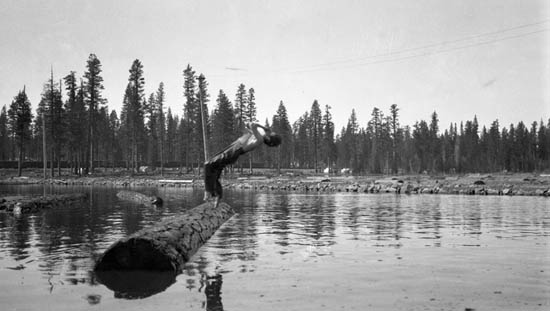
The Westwood millpond, like Fletcher Walker’s colossal sawmill was substantially larger compared to other sawmill facilities. A complete description of its size, holding capacity and hot pond feature can be found in Volume One of the Red River series entitled: The Early Years.
A unique aspect associated with the millpond, it was the scene of numerous tragic deaths—none of which were work related. Those familiar with millponds, since they are a relic of a bygone era, would find it peculiar that fishing, log rolling and swimming were popular activities in Red River’s early years.
The following are three accounts of accidental drownings, each with its own unusual circumstances.
On Sunday July 29, 1914, the millpond claimed its first victim. Details are rather sketchy as to what transpired, since no one saw the accident. During the afternoon 19-year-old Willard Pierce was fishing where Robbers Creek entered the millpond. Others in the vicinity were swimming and later left. Later in the day, John Jeffreys discovered Pierce’s body face down in about three inches of water. Jeffreys and Charles Phelan pulled him out of the water, and attempted to resuscitate to no avail. During the Coroner’s Inquest it was revealed that last year Pierce was swimming in the millpond with friends. After swimming, Pierce had a fainting spell and collapsed for no apparent reason. It was presumed that he must have had a spell causing him to fall into the water resulting in an accidental drowning.
On March 5, 1925, Val Patterson and Clayton Wells arrived in Westwood looking for work. Red River always had openings and the two young men were hired immediately. Since everyone worked six days a week, it did allow much free time for the two men to get better acquainted with their surroundings. On Sunday, March 15, the duo decided to go around and take photographs of Westwood to send back home. When they arrived at the millpond, Wells wanted to stand on a log while Patterson took his picture. Patterson did not think this was a good idea, for it could be dangerous should the log roll. Wells, on the other hand, threw caution to the wind, and jumped on a log. The log rolled, throwing him into the water and holding him down. The frightened Patterson called for help, whereby a fire truck and ambulance arrived on the scene. Wells’ body had been submerged for nearly twenty minutes, before his body was located and pulled out of the water. For nearly an hour every attempt was made to revive him, but to no avail.
On Friday afternoon, October 1, 1926, 17-year-old Westwood High School student, Jose Nunez, was returning home in Old Town with other school companions. While crossing the footbridge that spanned the millpond that made it easier for residents of Old Town to access Westwood, someone in the group suggested they play “Follow the leader.” Nunez was selected leader. He decided to jump off the footbridge and onto a log, which rolled and he fell into the water. Nunez was pinned underneath the logs unable to surface. When he did not immediately reappear, two of his friends dived into the water, but were unable to locate him. In the meantime, the call of help was made. Nunez’s body by this time had been submerged for nearly fifteen minutes. It was only with the aid of pike poles his body was located and pulled out of the water. A doctor was present and attempted every means to resuscitate him, but it was too late.
Roadhouses
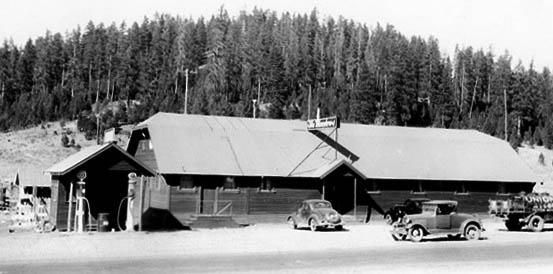
In 1916, California voters approved a $18 million bond measure to construct the state highway system. It was just the beginning of several multi-million bond measures to finance the massive road infrastructure. It was the state’s initial goal to have every county seat connected to a highway. Of local interest was the selection of the route between Red Bluff and Susanville. The highway was built in segments over a span of twelve years. In the summer of 1929 the final segment was completed between Westwood and Coppervale. In 1935, this route was designated at Highway 36—it was originally designated as Route 29.
It was just a matter of time when entrepreneurs would establish roadhouses to accommodate the traveling public. These places usually consisted of a restaurant, bar and gas station, and some with dance floors. There were four roadhouses that operated between Susanville and Westwood. In 1921, the first one to open was the Chateau, later renamed Deerhaven, just west of Devil’s Corral. Then there was The Meadows at Coppervale. This became quite an interesting little hub. In 1937, Bert Bain built a ski jump for winter enthusiasts. In 1939, Hubert Hill established a Red & White Grocery store there. The Red & White is the only building remaining, though no longer used for commercial purposes. Some people will remember it as Mike’s Lodge. Just a short distance from The Meadows was the very lively place known as the 1-0-1 Nite Club. Last, but not least, at Goodrich was Tunison’s and later became known as Phil’s place. It burned down in 1961, but its fireplace and chimney remain as a landmark to a bygone era. The complete history of these establishments can be found in Red River: The End of an Era.
The Kangaroo Kicker
 A little known character was Charles J. Mitchell who came to Westwood in 1919 and worked as a statistician. Mitchell sought refuge at Westwood. He was not hiding from the law, though some say he was, but to hide from fame. He did a great job in his disappearance act, thanks in part to World War I, which provided cover. His brother Andy, thought he returned to his native Australia to enlist in World War I and died in the War. His abandoned wife used the status of widow.
A little known character was Charles J. Mitchell who came to Westwood in 1919 and worked as a statistician. Mitchell sought refuge at Westwood. He was not hiding from the law, though some say he was, but to hide from fame. He did a great job in his disappearance act, thanks in part to World War I, which provided cover. His brother Andy, thought he returned to his native Australia to enlist in World War I and died in the War. His abandoned wife used the status of widow.
In Westwood, Mitchell was involved in many social activities, including the Secretary as the Westwood Auto Club and was a regular speaker at Memorial Day exercises. But he kept his private life private.
Mitchell’s tranquility eventually came to an end. In the fall of 1934 he learned that his alma mater the University of Wisconsin planned to erect a memorial in honor of Patrick John O’Dea, that school’s famed football kicker of the late 1890s. This was troublesome for Mitchell, since O’Dea was not dead, but was reincarnated as Mitchell. He decided to step forward to announce to the world that the great Pat O’Dea was alive. The San Francisco Chronicle broke the story, and became headline news throughout the nation. There were skeptics, especially his brother Andy who was positive his brother was dead. He heard sightings time to time, including a piano player in a bar in Reno who claimed he was the great O’Dea. University officials were leery as well. They assembled several of his football teammates to put together a list of questions that only O’Dea could answer, which he did with flying colors. In November he attended the University of Wisconsin homecoming and received a hero’s welcome. Life was not the same when he returned to Westwood, and with numerous job offers he left there in the fall of 1935. The day before he died in 1962 he was inducted into the College Football Hall of Fame. More about Pat O’Dea is highlighted in Red River: End of an Era. (O’Dea photo courtesy of University of Wisconsin Madison, Archives.)